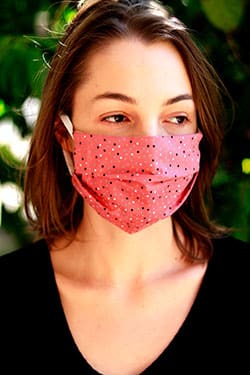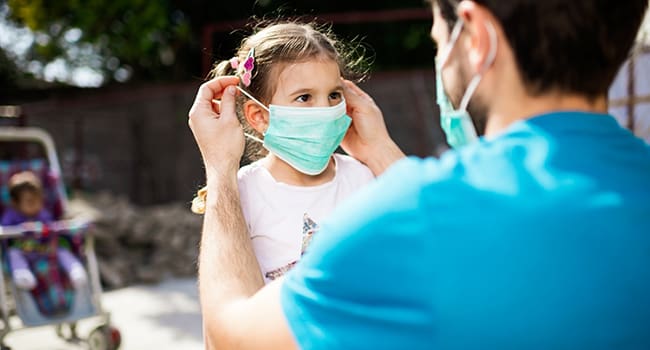Wearing a mask is safe and doesn’t physically limit breathing, said respirologist Christopher Ewing, of the U of A’s Faculty of Medicine & Dentistry. “They don’t affect the concentration or uptake of oxygen in any way, and there is no significant trapping or rebreathing of carbon dioxide.”
Though conditions such as autism or sensory processing disorders may prevent someone from wearing a mask due to intolerance of the facial sensations, adults or children with asthma or other lung conditions can safely wear them, he added.

Photo by Luiza Braun
“Masks don’t add enough additional resistance to the airways to limit air flow in any significant way, even for patients with lung disease. If anything, when people have an obstructive lung disease such as asthma or COPD, breathing against resistance can actually help keep airways open and prevent them from collapsing during exhalation.”
Any feelings of breathing discomfort that people feel while wearing a mask are usually based on dysfunctional breathing patterns that can develop while wearing one, Ewing said.
“Often, the problems are due to the direct physical sensation of wearing a mask, feeling anxious about it or having other common issues such as glasses fogging up, so people may subconsciously change their breathing patterns.”
Breathing too deeply or quickly, known as hyperventilation, can bring on feelings of dizziness, while breathing too little or unconsciously holding our breath can lead to feeling short of breath.
People may also stop breathing out too soon during the respiratory cycle, leading to “breath stacking” and hyperinflation, he said.
“The lungs can get very full of air when people do not breathe all the way out with each breath. The lungs get more and more full with each breath, and it can get very uncomfortable to continue to breathe at these high lung volumes. It’s like trying to blow more air into an already full balloon. If this happens, people need to relax their muscles, and focus on breathing all the way out before they take their next breath.“
However, everyone – including kids – can learn to master their masks by practising some breathing techniques, Ewing suggested.
Try box breathing
“Normally, it takes twice as long for us to breathe out as it does to breathe in. Breath stacking and hyperinflation, which develop when the exhalation is shortened or cut off early, is a common dysfunctional breathing pattern that can develop while wearing a mask.”
Box breathing, used often in yoga, visualizes the four sides of a box as the four parts to breathing: breathe in for two seconds, hold that breath in for two seconds, breathe out completely while relaxing the chest and abdomen muscles for two seconds, and then stay relaxed for two seconds before starting to breathe in again.
“It helps regulate your breathing in a more conscious way, by giving the body enough time to fully breathe in and breathe out, and resetting any dysfunctional breathing patterns that have developed. It can also reduce stress and anxiety.”
Try belly breathing
The stress of wearing a mask can cause some people to breathe using their neck and chest muscles, which are less efficient than the diaphragm, the main respiratory muscle that sits between your chest and your abdomen. Belly breathing—focusing on using only your diaphragm to breathe—can help relieve that tension.
“Put a hand on your belly while you breathe. You should feel your hand move away from you when you breathe in, and towards you as you breathe out. This helps prevent your body from using extra muscles and energy to breathe, by using only the most efficient respiratory muscle.”
Don’t be preoccupied with wearing the mask
Focus on the task at hand, whether that’s shopping, driving or playing.
“Let the brain’s respiratory autopilot take over,” said Ewing. Eventually, the mask becomes less noticeable. “We can get used to it, just like we get used to wearing glasses or contact lenses.”
Start small to get kids used to wearing masks
“The vast majority of kids can get used to wearing masks by using desensitization strategies,” said Ewing.
Start by having your child wear one for only a few minutes at a time, during a fun distraction like playing a video game or watching a show. Then, start to lengthen the time and frequency that they wear it during the weeks leading up to school. Or make a silly game of it.
“They can pretend they’re a superhero or a ninja. Parents can put their mask on at the same time and play together. The longer they can keep the mask on, and the more positive reinforcement they get afterwards, like hugs and high fives, the longer they will be able to tolerate it the next time they wear it.”
Experiment with different styles, fabrics and patterns to find a mask your child likes. “Let them help pick it out if you can, so they feel like they have some control over what they wear.”
Explain why it’s important
When school starts, parents and teachers need to be up front with children about the reasons for wearing a mask, he added.
“Kids by nature love to be helpers, and by wearing a mask they are helping to protect their friends, their teachers and themselves. Explaining that masks can help protect against the spread of germs is how we can get kids to buy in.”
| By Bev Betkowski
This article was submitted by the University of Alberta’s online publication Folio, a Troy Media content provider partner.
The views, opinions and positions expressed by columnists and contributors are the author’s alone. They do not inherently or expressly reflect the views, opinions and/or positions of our publication.

